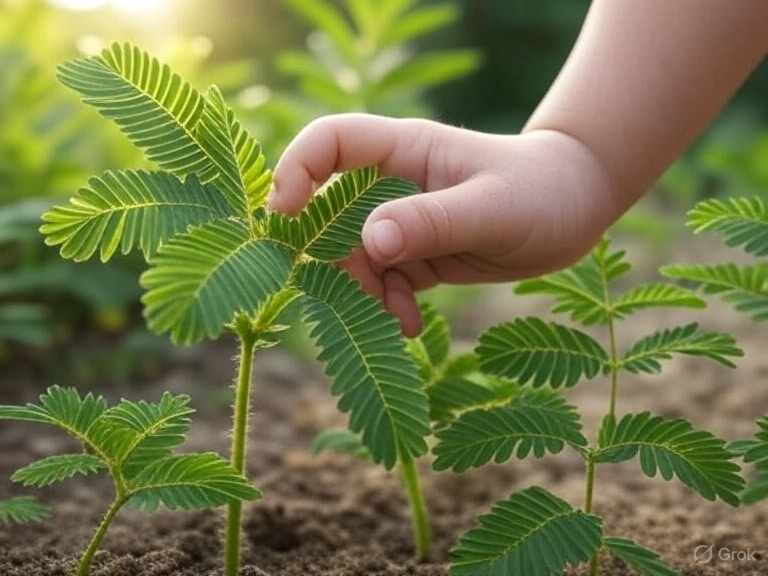Do Plants Have Secret Feelings?
Have you ever talked to your plants at home? Maybe you said, “Grow big and strong!” or gave them a little pat on the leaf. Many kids wonder: Can plants feel things like humans and animals do?
At first, the answer seems simple: plants don’t have brains, hearts, or nerves like we do. So they can’t feel pain, happiness, or sadness the way animals can.
But here’s the twist—plants are not just silent and boring. They can sense the world around them. They can react to light, touch, sound, and even danger. In their own special way, plants do “feel” things, just not the way we imagine!
Let’s explore this green mystery together.
What Does “Feeling” Really Mean?
When we say we “feel,” we usually mean:
- Touch – Like when you feel a soft blanket.
- Emotions – Like being happy, sad, or excited.
Plants don’t have emotions like humans, but they do react when something touches them or when their environment changes. Instead of nerves, plants use cells, chemicals, and signals to sense the world.
So, while plants don’t feel like we do, they still have their own version of “awareness.”
How Plants React to Light
Have you noticed that plants on a windowsill always bend toward the sunlight? This is called phototropism (photo = light, tropism = movement).
- Plants can sense where light comes from.
- They grow toward the light so their leaves can catch more sunshine.
- Without this ability, plants would not get enough energy to make food.
So, in a way, plants are always chasing the sun!
Plants and the Power of Touch
One of the most amazing examples of plant “feeling” is the Mimosa pudica, also called the “touch-me-not” plant.
- When you touch its leaves, they quickly fold up.
- After a few minutes, the leaves open again.
This happens because the plant moves water out of its cells when touched, making the leaves collapse.
Other climbing plants, like peas and vines, also use touch. When their tendrils feel a stick or fence, they wrap around it to climb higher.

Can Plants Hear and Smell?
You may be surprised, but plants can sense sounds and smells in their own way!
- Sounds – Some studies show plants grow faster when they “hear” soft music or vibrations.
- Smells – Plants release special chemicals into the air when they’re attacked by insects. Other nearby plants “smell” these chemicals and prepare their defenses.
It’s like plants are sending each other secret warning messages!
Do Plants Feel Pain?
This is a tricky question.
- Animals feel pain because they have a brain and nerves.
- Plants don’t have these, so they don’t “hurt” in the way we do.
But plants can sense damage. For example:
- When a leaf is cut, the plant releases chemicals to heal itself.
- It may also release smells that warn other plants.
So, while plants don’t cry or feel sad, they still “notice” when something is wrong.
How Plants Communicate
Did you know plants can “talk” to each other? Not with words, of course, but with chemicals and signals.
- Roots – Send signals underground to share food and warn of danger.
- Leaves – Release smells to scare off insects.
- Flowers – Use colors and scents to “call” bees and butterflies for pollination.
Some scientists even call this the wood-wide web, where trees and plants are connected through fungi underground, sharing nutrients and information.
Amazing Examples of Plant “Feelings”
Here are some cool plant tricks:
- Venus Flytrap – Its leaves snap shut when an insect touches tiny hairs. It’s like a green mouth!
- Sunflowers – Their heads turn to follow the sun across the sky every day.
- Corn Plants – Can “hear” caterpillars munching their leaves and release smells to call wasps for help.
- Willow Trees – Release chemicals that help nearby trees resist pests.
These show that plants are not passive—they’re smart survivors.
What Scientists Say About Plant Feelings
Scientists don’t agree completely about whether plants “feel.”
- Some say plants are aware but not conscious.
- Others believe plants may have their own way of sensing that we don’t yet understand.
What we know for sure is that plants react to their environment in amazing ways. They are alive, sensitive, and full of surprises.
Why This Matters for Kids
Learning about plant “feelings” teaches us important lessons:
- Respect Nature – Plants are living things that need care.
- Science is Full of Mysteries – Not everything is fully understood yet.
- Connection to the Earth – Plants provide us with food, oxygen, and beauty.
The more we study plants, the more we realize they are extraordinary.
Fun Plant Facts for Kids
- Bananas are berries, but strawberries are not!
- Bamboo is the fastest-growing plant and can grow almost 1 meter in a single day.
- Trees can live for thousands of years—much longer than humans.
- Some plants can “remember.” For example, Mimosa plants stop closing their leaves if touched again and again.
Isn’t that mind-blowing?
How You Can Care for Plants
If plants are this amazing, we should treat them kindly. Kids can help plants by:
- Watering them regularly.
- Giving them sunlight.
- Talking kindly to them (some studies suggest it helps!).
- Planting trees and flowers to support nature.
Taking care of plants is not just fun—it’s a way of giving back to the Earth.